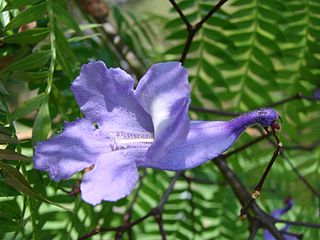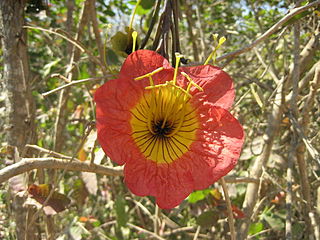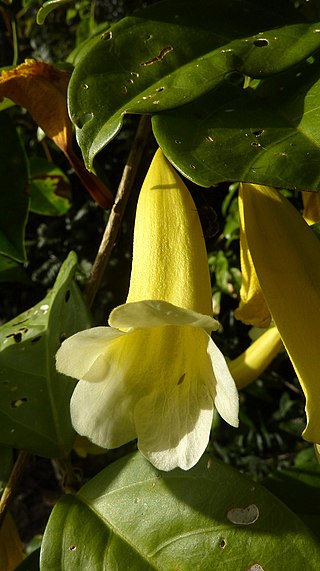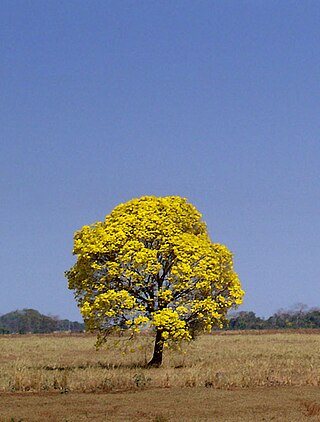
Tabebuia is a genus of flowering plants in the family Bignoniaceae. The common name "roble" is sometimes found in English. Tabebuias have been called "trumpet trees", but this name is usually applied to other trees and has become a source of confusion and misidentification.

Bignoniaceae is a family of flowering plants in the order Lamiales commonly known as the bignonias or trumpetvines. It is not known to which of the other families in the order it is most closely related.

Jacaranda is a genus of 49 species of flowering plants in the family Bignoniaceae, native to tropical and subtropical regions of the Americas. The generic name is also used as the common name.

Bignonia is a genus of flowering plants in the family Bignoniaceae. Its genus and family were named after Jean-Paul Bignon by his protégé Joseph Pitton de Tournefort in 1694, and the genus was established as part of modern botanical nomenclature in 1753 by Carl Linnaeus. Species have been recorded from the southern USA, Central to most of South America.

Stereospermum is a genus of trees in the paleotropical clade of the family Bignoniaceae. A species of Stereospermum is used in herbal medicine in Ayurveda as well as it is an integral part of the culture and tradition of the cold desert biosphere reserve.

Fernandoa is a genus of plants in the family Bignoniaceae.

Anemopaegma is a genus of flowering plants in the family Bignoniaceae. Species of Anemopaegma along with many other unrelated plants go by the name of catuaba.

Mansoa is a genus of tropical, flowering vines in the family Bignoniaceae.

Markhamia is a genus of flowering plants in the family Bignoniaceae. The genus is named after Clements Markham.

Handroanthus is a genus of flowering plants in the family Bignoniaceae. It consists of 30 species of trees, known in Latin America by the common names poui, pau d'arco, or ipê. The latter sometimes appears as epay or simply ipe (unaccented) in English. The large timber species are sometimes called lapacho or guayacan, but these names are more properly applied to the species Handroanthus lapacho and Handroanthus guayacan, respectively.

Astianthus is a monotypic genus of flowering plants in the Bignoniaceae family. The sole species is Astianthus viminalis. It is known by the common names achuchil in Mexico and chilca in Guatemala and Honduras.

Amphilophium is a genus of flowering plants in the family Bignoniaceae, native to South America. Amphilophium crucigerum has escaped from cultivation elsewhere, and has become an invasive weed in Australia.

Tanaecium is a genus of flowering plants in the family Bignoniaceae, native to south and Central America.
Fridericia elegans is a species of plants in the family Bignoniaceae. It is found in Brazil, where it is poisonous to livestock and has caused severe losses.
Pleonotoma is a genus of tropical, flowering lianas located in the family Bignoniaceae.

Dolichandra is a genus of flowering plants in the family Bignoniaceae, native to Latin America and the Caribbean. They are climbing lianas with trifid and uncate tendrils. The best-known species is Dolichandra unguis-cati.

Heterophragma is a genus of two species of tree, constituting part of the plant family Bignoniaceae. The species are found in Southeast Asia and India.
Sparattosperma is a genus of flowering plants belonging to the family Bignoniaceae.
Pachyptera is a genus of flowering plants belonging to the family Bignoniaceae.
Martinella is a genus of flowering plants belonging to the family Bignoniaceae. It is a genus of Neotropical lianas within the tribe Bignonieae.














